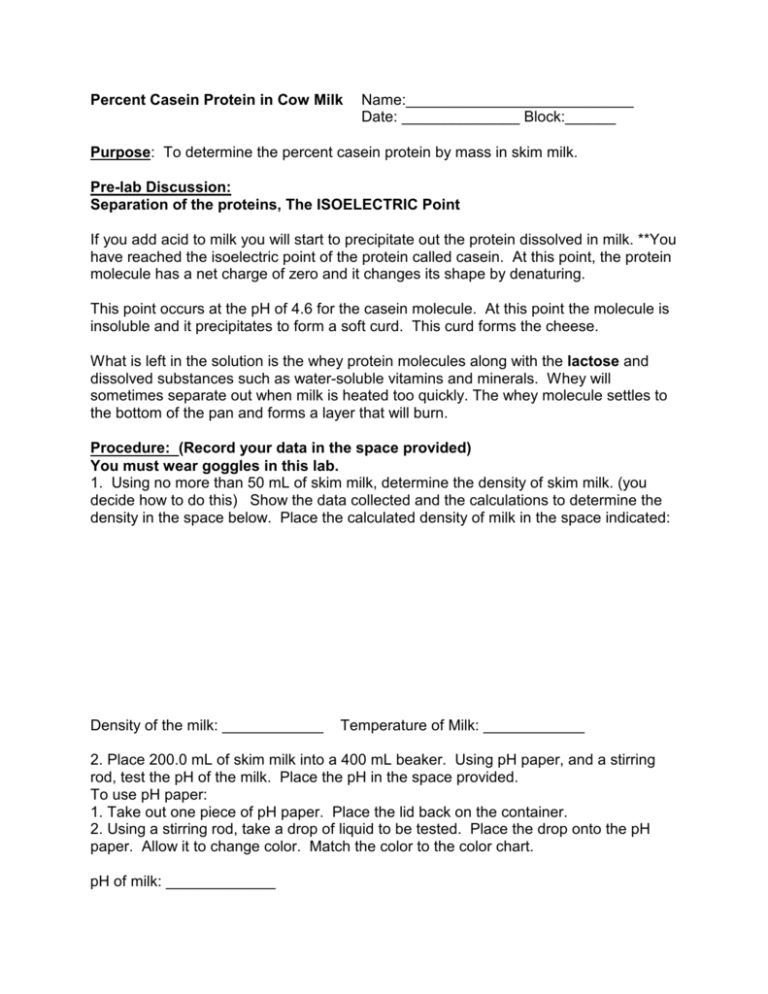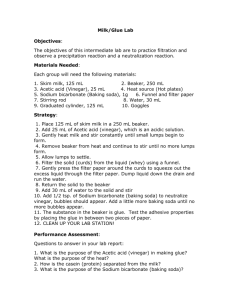PERCENTAGE OF CASEIN IN COW MILK
advertisement

Percent Casein Protein in Cow Milk Name:___________________________ Date: ______________ Block:______ Purpose: To determine the percent casein protein by mass in skim milk. Pre-lab Discussion: Separation of the proteins, The ISOELECTRIC Point If you add acid to milk you will start to precipitate out the protein dissolved in milk. **You have reached the isoelectric point of the protein called casein. At this point, the protein molecule has a net charge of zero and it changes its shape by denaturing. This point occurs at the pH of 4.6 for the casein molecule. At this point the molecule is insoluble and it precipitates to form a soft curd. This curd forms the cheese. What is left in the solution is the whey protein molecules along with the lactose and dissolved substances such as water-soluble vitamins and minerals. Whey will sometimes separate out when milk is heated too quickly. The whey molecule settles to the bottom of the pan and forms a layer that will burn. Procedure: (Record your data in the space provided) You must wear goggles in this lab. 1. Using no more than 50 mL of skim milk, determine the density of skim milk. (you decide how to do this) Show the data collected and the calculations to determine the density in the space below. Place the calculated density of milk in the space indicated: Density of the milk: ____________ Temperature of Milk: ____________ 2. Place 200.0 mL of skim milk into a 400 mL beaker. Using pH paper, and a stirring rod, test the pH of the milk. Place the pH in the space provided. To use pH paper: 1. Take out one piece of pH paper. Place the lid back on the container. 2. Using a stirring rod, take a drop of liquid to be tested. Place the drop onto the pH paper. Allow it to change color. Match the color to the color chart. pH of milk: _____________ 3. Using the volume and the density of skim milk, determine the mass of the skim milk in your 200.0 mL of milk. Show your work and calculation in the space below: Box your mass and use the correct number of significant figures and units. 4. Slowly heat up your milk on a hot plate stirring with a stirring rod until condensed water vapor comes off the surface of the milk. Take the temperature of the milk and when the temperature is around 70°C, remove the beaker from the hot plate and place on the tabletop. (The top of the beaker should not be hot, but you may use beaker tongs if you desire.) 5. Slowly add vinegar or lemon juice(you would add lemon juice at home to make lemon cheese) to your beaker stirring constantly with your stirring rod. As soon as the mixture starts to curdle, stop adding the acid and continue to stir. 6. Test the pH of the solution with pH paper and record the pH in the space provided. pH of the mixture when it begins to curdle:_______________ 7. Now add an additional 10 mL of acid to your mixture. Allow the mixture to settle while you set up to filter the mixture. 8. Filter the mixture using the funnel and filter paper. Collect the filtrate in a large beaker. Allow the curds to dry overnight and obtain the mass of the curds tomorrow or the next class day and record the mass in the space provided. Mass of filter paper + curds:_____________ Mass of filter paper:________________ Calculation of the mass of curds: Calculations: 1. Calculate the percent by mass of casein protein in your skim milk. Show all calculations. Use the percent composition equation. 2. Using the information from your pre-lab reading, calculate the theoretical amount of casein protein found in your 200.0 mL sample. The reading stated that 3.5% of the milk should be protein and of that protein, 82% should be casein protein. Show all of your work. 3. Using your answer in calculation #2 as the true value, calculate the percent error in your experimentation. Questions: Making Cheese Read over the article on Making Cheese in Chemmatters and then answer the questions for your report. 1. What word is cheese derived from? ________________________ 2. Even though there are hundreds of varieties of cheeses, what is the basic principle of cheese making? 3. What is the difference between fresh cheese and aged cheese? 4. Did you make a fresh cheese today or an aged cheese? ____________ 5. Give examples of aged cheeses: 6. Milk is a mixture. What substances are found in milk? 7. If you were to start with 100 kg of milk, how much cheese would this make? ____________________ 8. Convert this amount to ounces: (1kg = 2.2 lbs and 1 lb = 16 oz) Show all work and box your final answer. 9. The sugar that is found in milk is called lactose. Lactose is formed by the dehydration synthesis of a glucose molecule with a galactose molecule. In the space below, draw a lactose molecule: 10. Ripening a cheese takes three steps. Describe these three steps below: 11. How was rennin originally produced? 12. How is rennin made today? 13. What effect does salt have on the cheese? 14. Describe how the cheese you tried today tasted: 15. Did you have to have fat in milk to make cheese? Yes or no? ________ 16. UHT means ultra high temperature milk. This milk does not have to be refrigerated until it is opened. Parmalat is the brand name for this type of milk in the store. Many people buy this milk and think that it is ok to store in the cupboard (which it is ok to do this) but then after they open it and use some of it, they try to store it back in the cupboard. The milk will spoil if you do this. What reason could you give for this? 17. After doing this lab, what substance makes up the greatest percentage of milk by mass? 18. What is cheese? How would you describe it? 19. What is your favorite kind of cheese? 20. If you had a choice of a piece of cheese or a candy bar, which would you chose? Alternate Method of coagulation: Instead of using acid to precipitate out the protein, use rennet (Junket) from the grocery store. If you can’t find it, ask a manager. It is used to make custards and ice cream. Students should heat up the milk until only 40° C, then add ½ tablet that has been crushed. You can use a mortar and pestle to grind it up. I just use a mallet and smash it up and split it between 2 groups. Alternate method is to use a scoopula and crush it. Add the rennet to the warm milk and within a few minutes, the protein should be curdled.




